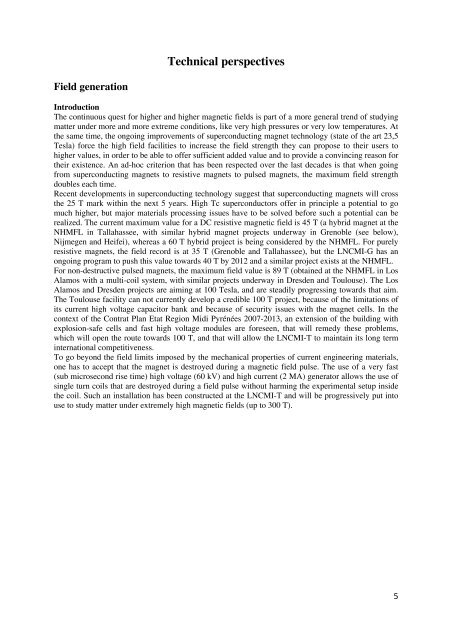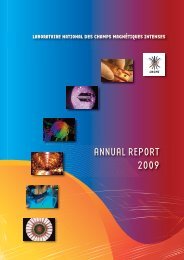Laboratoire National des Champs Magnétiques Pulsés CNRS – INSA
Laboratoire National des Champs Magnétiques Pulsés CNRS – INSA
Laboratoire National des Champs Magnétiques Pulsés CNRS – INSA
Create successful ePaper yourself
Turn your PDF publications into a flip-book with our unique Google optimized e-Paper software.
Field generation<br />
Technical perspectives<br />
Introduction<br />
The continuous quest for higher and higher magnetic fields is part of a more general trend of studying<br />
matter under more and more extreme conditions, like very high pressures or very low temperatures. At<br />
the same time, the ongoing improvements of superconducting magnet technology (state of the art 23,5<br />
Tesla) force the high field facilities to increase the field strength they can propose to their users to<br />
higher values, in order to be able to offer sufficient added value and to provide a convincing reason for<br />
their existence. An ad-hoc criterion that has been respected over the last deca<strong>des</strong> is that when going<br />
from superconducting magnets to resistive magnets to pulsed magnets, the maximum field strength<br />
doubles each time.<br />
Recent developments in superconducting technology suggest that superconducting magnets will cross<br />
the 25 T mark within the next 5 years. High Tc superconductors offer in principle a potential to go<br />
much higher, but major materials processing issues have to be solved before such a potential can be<br />
realized. The current maximum value for a DC resistive magnetic field is 45 T (a hybrid magnet at the<br />
NHMFL in Tallahassee, with similar hybrid magnet projects underway in Grenoble (see below),<br />
Nijmegen and Heifei), whereas a 60 T hybrid project is being considered by the NHMFL. For purely<br />
resistive magnets, the field record is at 35 T (Grenoble and Tallahassee), but the LNCMI-G has an<br />
ongoing program to push this value towards 40 T by 2012 and a similar project exists at the NHMFL.<br />
For non-<strong>des</strong>tructive pulsed magnets, the maximum field value is 89 T (obtained at the NHMFL in Los<br />
Alamos with a multi-coil system, with similar projects underway in Dresden and Toulouse). The Los<br />
Alamos and Dresden projects are aiming at 100 Tesla, and are steadily progressing towards that aim.<br />
The Toulouse facility can not currently develop a credible 100 T project, because of the limitations of<br />
its current high voltage capacitor bank and because of security issues with the magnet cells. In the<br />
context of the Contrat Plan Etat Region Midi Pyrénées 2007-2013, an extension of the building with<br />
explosion-safe cells and fast high voltage modules are foreseen, that will remedy these problems,<br />
which will open the route towards 100 T, and that will allow the LNCMI-T to maintain its long term<br />
international competitiveness.<br />
To go beyond the field limits imposed by the mechanical properties of current engineering materials,<br />
one has to accept that the magnet is <strong>des</strong>troyed during a magnetic field pulse. The use of a very fast<br />
(sub microsecond rise time) high voltage (60 kV) and high current (2 MA) generator allows the use of<br />
single turn coils that are <strong>des</strong>troyed during a field pulse without harming the experimental setup inside<br />
the coil. Such an installation has been constructed at the LNCMI-T and will be progressively put into<br />
use to study matter under extremely high magnetic fields (up to 300 T).<br />
5







